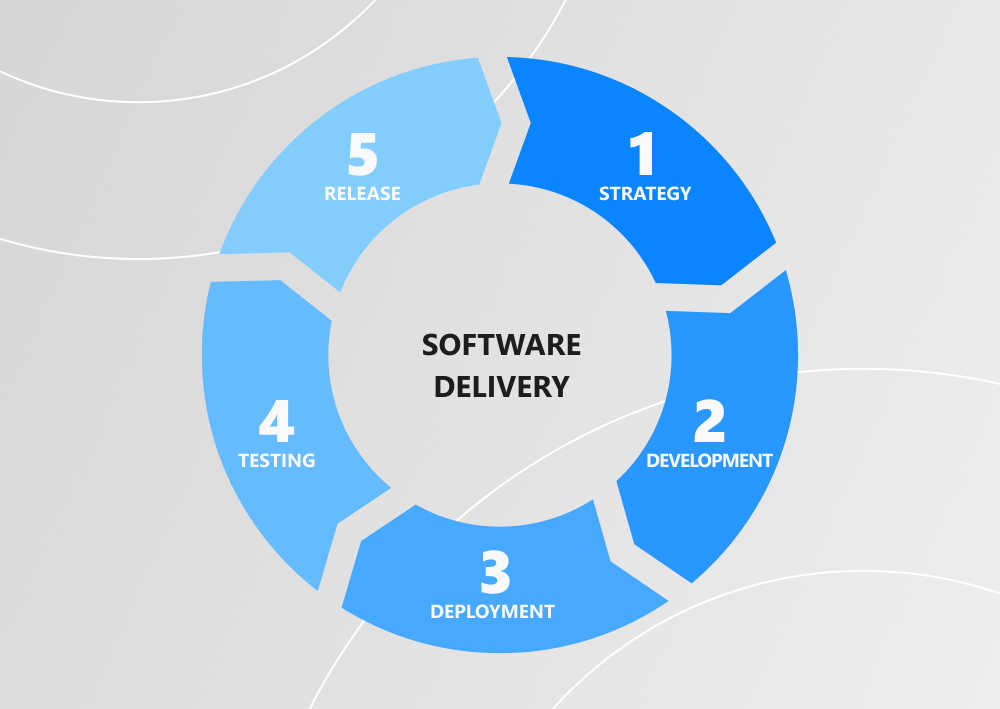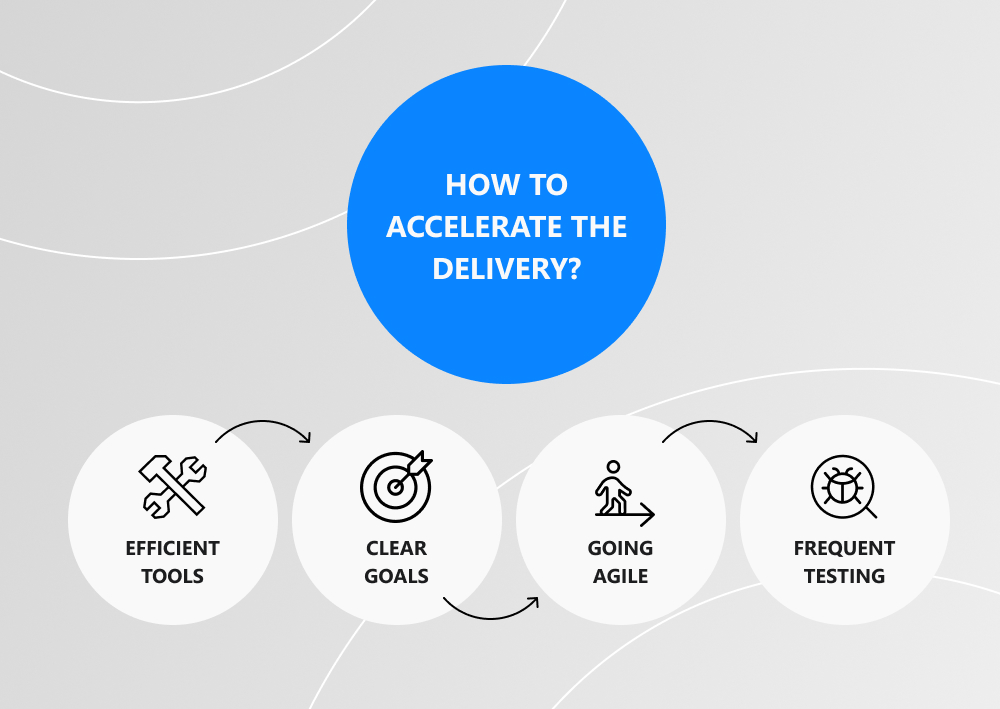The ability to release quality software products quickly helps a company to stay afloat and retain its competitive power. But when it comes to successful software delivery, it's essential to keep in mind the entire development process. According to Statista, the number of software companies that managed to deliver their products on time during the last 5 years has greatly increased. Still, some enterprises keep struggling with this challenge.
So, what is software delivery, and how can you speed it up without losing the quality?
written by:
Anton Rykov
Product Manager
The ability to release quality software products quickly helps a company to stay afloat and retain its competitive power. But when it comes to successful software delivery, it's essential to keep in mind the entire development process. According to Statista, the number of software companies that managed to deliver their products on time during the last 5 years has greatly increased. Still, some enterprises keep struggling with this challenge.
So, what is software delivery, and how can you speed it up without losing the quality?
Contents
What Is Software Delivery?
Software delivery refers to the entire path a software product goes through before it becomes available for end-users. In its broader definition, the term embraces strategy planning, development, deployment, testing, and release. So, let’s analyze software delivery from this perspective.
Another notion you should keep in mind is continuous delivery that is a part of the CI/CD method. It covers the whole development process and involves automation and short-cycle software creation. Such an approach accelerates the release and enables development teams to cut costs and reduce the risks of delivering any changes.
When your digital product goes live, it's crucial to monitor customer experience and add new features to it in compliance with received feedback, so certain adjustments inevitably follow the software release. Still, you can minimize them by enhancing the development stage.
Indeed, the use of readable code in combination with proper testing tools greatly simplifies the delivery, but this is not enough. To provide seamless release, you need to enhance each stage of development and embed modern practices into the workflow structure.
Advantages of Software Delivery Management
The research conducted in 2020 by CloudBees has shown that Software Delivery Management (SDM) greatly impacts the industry’s capabilities and speeds up its digital transformation. So, in the report, SDM was defined as “a core competency for any organization responsible for delivering business value via software applications and systems.” And that’s absolutely true!
When software developers work together on a complex project, it's essential to organize their workflow most efficiently. Accurate allocation of resources and proper team management allow IT companies to deliver excellent products that satisfy customer needs. But this is hard to achieve without a dedicated software delivery manager. So, what are the benefits of hiring such a specialist?
No Silos
To achieve excellent performance, the first thing you should do is to get rid of all communication barriers. When working on a project, many organizations face the challenge of distributing tasks among different workers. Also, in some cases, development teams encounter obstacles to keeping in touch with business stakeholders.
Luckily, you can effectively solve these problems with the help of a delivery manager who breaks down all the silos and enhances collaboration.
Optimized Workflow
Once the barriers are removed, you can proceed to workflow streamlining. When a heterogeneous group of specialists develops a complex digital product, providing everyone with access to modern tools and services is equally crucial as creating a project roadmap.
Thus, a delivery manager establishes the guidelines, keeps track of the interim results of each team member, and makes sure that the deadlines are met. Such an approach leads to workflow optimization and accelerates delivery.
Budget Control
If you create custom software, it's essential to have a specialist who monitors how the team sticks to the budget. During the development stage, the changes and adjustments that can reduce the cost-efficiency of your product and lead to project delays are inevitable. So, having a dedicated manager who keeps track of resource and time allocation will allow your product to be successfully delivered to the customers.
Timely Feedback
Feedback processing enhances the company's flexibility and enables it to meet client expectations. But keep in mind that only continuous feedback can guarantee accelerated deployment, so don’t forget to collect data at every stage of the SDLC. As you might understand, a delivery manager effectively performs this task and enhances the quality of your product by analyzing real-time insights.
Faster Time to Market
With a proactive software delivery manager on board, not only will you save money in the long run and get a quality digital product, but also accelerate the time to market of your best-of-breed solution. When handpicking such a specialist, pay attention to the technical background and the latest projects, as well as interpersonal skills.
Four Best Practices to Accelerate Software Development
Time is one of the most valuable resources for any business. That's why, to meet customer demands, you should be able to deliver a quality software product ASAP. Hiring a delivery manager greatly facilitates the whole development process, but if you’re aiming for excellent results, it's crucial to combine human supervision with digital solutions.
So, let's have a look at the best practices that can help you speed up development and release.
Efficient Teams, Efficient Tools
Hiring well-trained specialists definitely simplifies the development routine, so, don't hesitate to expand your team. If your project is rather complicated and requires more developers, outsourcing IT specialists can be a perfect option.
Once the team is packed, you need to optimize the collaboration between different departments, so automating the workflow can become a perfect solution. For this purpose, such business digital tools as Trello, Smartsheet, Jira, and other DevOps platforms come in handy. With their help, you can monitor the development progress, obtain relevant data, and make required updates very quickly.
Clear Goals
Well-defined goals and deadlines can definitely accelerate the delivery. When everyone understands the task, it becomes possible to estimate its complexity and optimize the workflow.
When facing tight deadlines, task splitting proves to be a highly effective strategy. This technique is particularly valuable for managing complex projects. By breaking down a large goal into bite-sized tasks, teams can work more efficiently. Additionally, this approach can alleviate psychological stress among team members. When employees see progress with each completed task, it boosts their morale and motivates them to pursue subsequent goals.
Going Agile (Or Not)
The Agile method is a great solution for large-scale projects carefully planned out by active leaders. An iterative development approach and staged focus on building features are crucial for Agile. Also, its sprint technology helps to deliver the product faster.
Although the Agile approach has numerous advantages, you can apply any other method to your project. Thus, Rapid Application Development (RAD) is perfect when you need a product that can easily adapt to customer needs, and Waterfall is an excellent solution for a big project based on careful planning and sequence.
Don’t Stop Testing
Applying various testing methods at every stage of software development gives you more flexibility and helps to speed up the release. Still, to achieve better results, try to combine both manual and automated testing technologies.
It's obvious that for any business to stay appealing to the customers is a major priority. That's why it's essential not only to test code functionality and software performance but also to monitor the value of your product on the market. Since frequent testing enables you to be more flexible and adapt quickly to the changes, delivering at a quick pace and meeting customer expectations becomes much more accessible.
Summing Up
Delivering products or services to customers is a real challenge for any company, and the software development industry is no exception. However, it's possible to accelerate the whole process to meet the demands of end-users. A combination of effective management, workflow automation, and careful testing is one of the best practices you may choose to enhance the delivery.
If you want to find out more tips on effective software delivery that can be perfect for your business, please contact our specialists. Qulix has great experience in the software development field and is ready to provide flawless solutions for your ideas.

Contacts
Feel free to get in touch with us! Use this contact form for an ASAP response.
Call us at +44 151 528 8015
E-mail us at request@qulix.com









